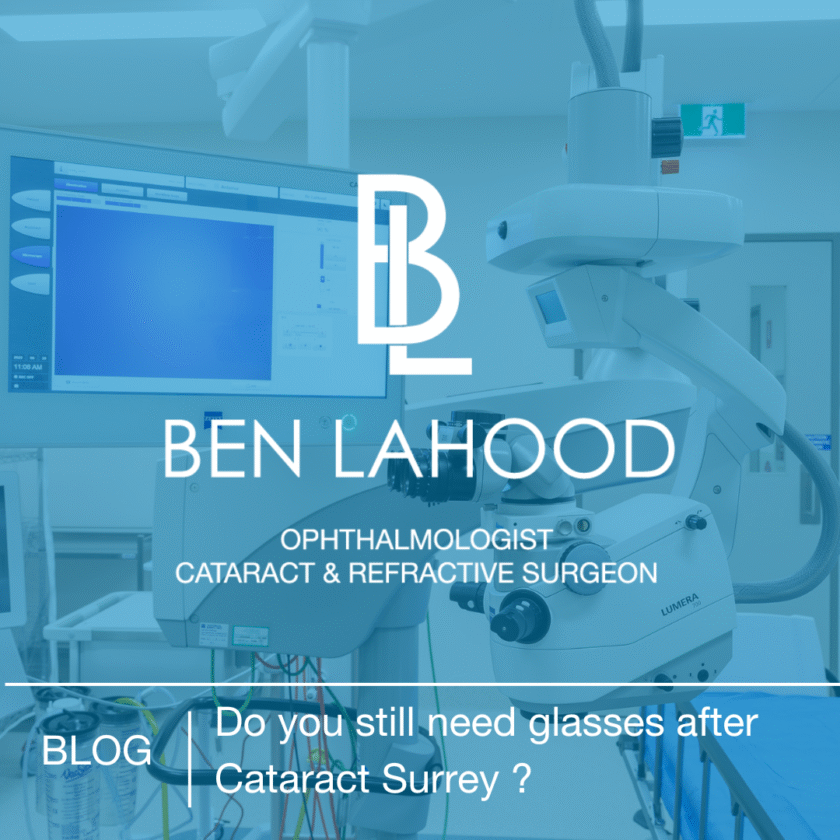
Do You Still Need Glasses After Cataract Surgery?
What is a cataract?
A cataract occurs when the natural lens inside the eye becomes cloudy, making it harder for light to pass through clearly. This often happens gradually as part of ageing, though other factors like diabetes, long-term use of certain medications, or eye injury can also contribute. Symptoms include blurred vision, faded colours, glare from lights, and difficulty driving at night.
How are cataracts treated?
Cataract surgery is the only way to remove a cataract once it starts to interfere with daily life. The procedure is commonly performed and proven. It involves carefully removing the cloudy natural lens and replacing it with a clear artificial lens, called an intraocular lens (IOL).
For many people, this restores vision that is brighter and clearer. However, while surgery removes the cloudiness caused by cataracts, it does not always remove the need for glasses. Whether glasses are still required depends on the type of IOL chosen, the health and shape of the eye, and the individual’s visual goals.
Why Glasses May Be Needed After Surgery
Cataract surgery removes the cloudy natural lens and replaces it with a clear artificial one. While this restores vision, some people still need glasses afterwards. Reasons may include:
- Lens type: Standard intraocular lenses (IOLs) usually focus at one distance. You may still need glasses for reading, computer work, or close tasks.
- Astigmatism: If the surface of the eye is more oval than round, glasses may still be needed unless a toric IOL is used.
- Fine detail: Even with excellent overall vision, some people prefer glasses for tasks that require very sharp focus, like sewing or detailed reading.
- Night vision: Certain lenses can cause glare or halos, and glasses may help improve comfort when driving at night.
Your ophthalmologist will explain these possibilities before surgery so you know what to expect and can make the best decision for your lifestyle and visual needs.
Selecting the best Intraocular Lenses (IOLs) for you
A key part of cataract surgery is selecting the artificial lens, known as an intraocular lens (IOL), to replace the cloudy natural lens. The type of IOL chosen has a strong influence on whether glasses will still be needed afterwards.
- Monofocal lenses: These are most commonly used. They provide clear vision at a single distance, usually for driving or other distance tasks. Reading glasses are often still required.
- Multifocal or trifocal lenses: These lenses are designed to provide a range of vision, from near to far. They can reduce the need for glasses, however, some patients notice glare or halos around lights, especially at night.
- Extended Depth of Focus (EDOF) lenses: These give clear vision over a continuous range, especially from distance to intermediate (such as computer use). Glasses may still be needed for very close tasks.
- Toric lenses: For patients with astigmatism, toric lenses help correct the irregular shape of the cornea and may reduce the need for glasses for distance vision.
Each lens type has benefits and limitations. No single option guarantees complete freedom from glasses, which is why discussing your goals and lifestyle with your ophthalmologist is an important part of preparing for surgery.
Setting Realistic Expectations
Cataract surgery is one of the most successful procedures performed worldwide, and it is proven to provide brighter, clearer vision. However, it is important to understand that its purpose is to remove the cloudy lens caused by cataracts, not necessarily to eliminate the need for glasses.
While modern intraocular lenses (IOLs) offer excellent outcomes, no lens can guarantee perfect vision at every distance in all situations, and some suitability will depend on the individual. Some patients achieve excellent vision without glasses for most daily activities, while others still prefer to wear them for tasks like reading, driving at night, or detailed close work.
The best way to understand what to expect is through a personalised consultation. Your ophthalmologist will assess the health of your eyes, explain the different lens options, and discuss your lifestyle needs. This process helps ensure that you are well informed about the likely outcome of surgery and whether glasses will still play a role in your day-to-day vision and allow you to make an informed choice.
Frequently Asked Questions
How many days of rest are needed after cataract surgery?
Most people only need a short period of rest after cataract surgery as the procedure is minimally invasive and performed as day surgery. Vision usually improves within the first one to three days. It is recommended that you have a responsible adult with you for the first 24 hours. During the first few days, avoid driving, rubbing your eyes, or getting water directly into the eye. Swimming, eye makeup, and contact sports should be avoided for at least a week.
How long does it take for cataract surgery to heal?
Cataract surgery recovery happens over a period of time and in stages. Many people notice clearer vision in the first few days, but the eye continues to heal over several weeks. Follow-up appointments are typically scheduled at one day, one week, and one month after surgery to monitor healing. Eye drops are prescribed during this time to support recovery. Although the eye feels comfortable quickly, full healing and stabilisation of vision can take several weeks.
What is the average age for cataract surgery?
Cataracts often begin to affect vision from the age of 60 onwards, but surgery is recommended based on how much the cataract interferes with daily life, rather than age alone. Some people may need surgery earlier, while others manage well for longer.




